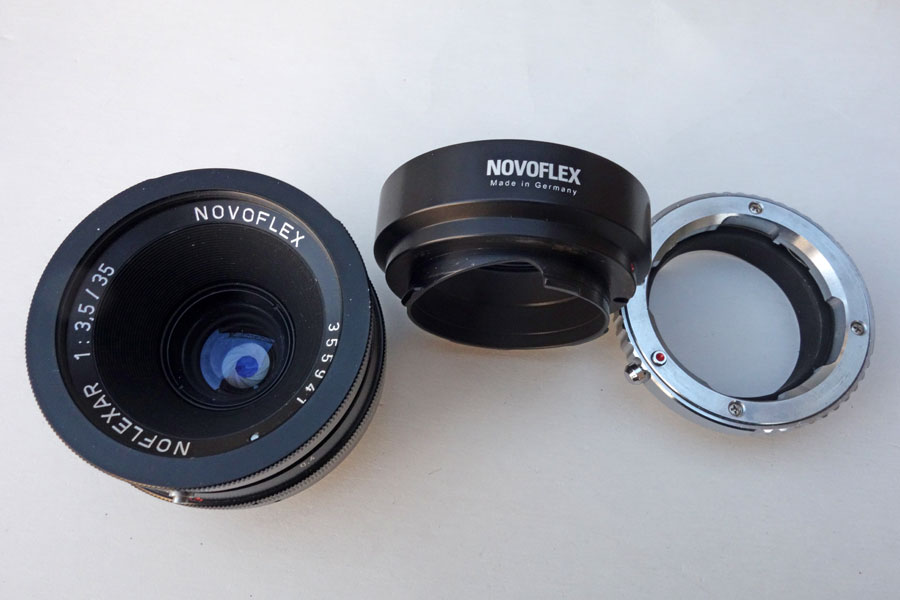Leica M (Typ 240): Close-Up Experiences - Part 1: Overview
Introduction and Overview of the Options | Close-up Lenses | Extension Tubes | Extension Bellows | Macro Lenses | Conclusions | References
Archive
This page presents an overview of close-up options for the Leica M (Typ 240) when using live view mode.
See also pages Close-Up Options (Live View) - Part 2: Practice I, Close-Up Options (Live View) - Part 3: Practice II, and Close-Up Options (Live View) - Part 4: Practice III for my practical experiences in this area, as well as pages Close-Up Options (Live View) - Part 5: Samples I and Close-Up Options (Live View) - Part 6: Samples II and Close-Up Options (Live View) - Part 7: Samples III for sample close-up photos with the Leica M (Typ 240).
Note: Page Close-Up Behavior of the M-Mount Lenses describes the close-up characteristics of the lenses when used without any close-up options.
Introduction and Overview of the Options
As a rangefinder camera, the Leica M is not well suited to close-up photography because of the parallax. Leitz/Leica developed the Visoflex system, which was an effort in itself. For details search the Web for "Visoflex" or see Leica Visoflex System - adjusting in a digital world by Stephen Gandy or the Wikipedia article Visoflex (in German). With the Leica M (Typ 240), however, things changed dramatically, because Leica added live view to the camera. While many users regards this as a break with the Leica tradition or declare that they do not use live view, for me it was the reason to buy this, and only this, Leica Model (at that time...). With respect to close-up/macro photography, in live view mode the M behaves like a system camera (or like a DSLR) and can use all the techniques that these can use: close-up lenses, extension tubes, extension bellows, and macro lenses. Here is an overview of the options that I will briefly describe below:
- Close-Up Lenses
- Lenses
- Achromats
- Extension Tubes
- Single Tubes (Short)
- Tube Sets (Configurable)
- Extension Bellows
- Macro lenses (there are only few options, though...)
- And, of course, any combination of all this
I should also mention that rangefinder lenses have a relatively large minimum distance and thus, are per se not well suited to close-up photography. I made some investigations into this topic for my M-mount lenses when used at the Ricoh GXR, that is, at an APS-C camera (see page Close-Up Behavior of the M-Mount Lenses (for Ricoh GXR)). For a full-format camera like the Leica M (Type 240), you get the same minimum distance, but a larger section, making things even worse... I repeated this investigation for the Leica M, and you can find the results on page Close-Up Behavior of the M-Mount Lenses (for Leica M).
In the following, I briefly discuss the options and present my own "investments" into the domain of close-up photos. Results of using these devices are presented on three separate pages (Close-Up Options (Live View) - Part 2: Practice I, Close-Up Options (Live View) - Part 3: Practice II, and Close-Up Options (Live View) - Part 4: Practice III).
Close-up Lenses
The simplest approach to extending the close-up abilities of a lens is to attach a close-up lens to its front (either directly or using a step-up or step-down adapter). You can use either single lenses or higher quality achromats. The main advantages of using close-up lenses are that there is no loss in light sensitivity and that attaching close-up lenses to your lens is easy (although it is still some effort for me...).
Lenses
If you use simple = single close-up lenses, image quality (sharpness) suffers somewhat, particularly, in the corners. It is up to you, whether you will find this acceptable or not. Close-up lenses are also prone to chromatic aberration.
Achromats
Achromats, which consist of two lenses, are an attempt to minimize chromatic aberration. They also deliver a better image quality in the corners (which may not be as important for many macro motives). Overall, achromats are the preferred choice when it comes to image quality, but they also come at a higher price (for example, the Marumi +5 achromat costs twice the price of the B+W +5 close-up lens). For photos of the Marumi +5 achromat see below.
Leitz/Leica delivered very good achromats with its Elpro series. These are no longer built, but are still expensive and hard to get. There are, of course, cheaper alternatives, among others, from Raynox and Marumi.
Stacking Lenses
Close-up lenses can be stacked to achieve various diopter values. I found, however, recommendations that, for quality reasons, not more than two close-up lenses should be stacked. For achromats, which offer higher quality, this restriction may not be valid. In the l-camera-forum, dkpeterborough reported to have used up to 3 Leitz Elpro VIb achromats (and he reported that up to 4 can be used). If you do not mind, you can stack any lenses for achieving higher magnifications, but the results may not be worthwhile...
My Lenses
For the Leica X Vario, I bought a cheap set of close-up lenses, which can be combined to achieve a "continuum" of diopter values, then a B+W +5 close-up lens, and finally two Marumi +5 achromats. I tested all these lenses on the X Vario extensively and reported on this on this Website. See the summary of my results on page Close-up Lens Experiments - Summary. For the Leica M (Typ 240), I will only discuss the Marumi +5 achromats.
My Marumi achromats have a filter thread of 52 mm (which is the minimum size for these achromats; Raynox offers smaller filter threads, but I learned about this too late...). Therefore, I bought a Quenox 43-52 mm step-up ring for the Leica X Vario and recently also a Quenox 46-52 mm step ring for the Leica M. These rings can be used on the M with my following lenses:
- 43-52 mm step-up ring: Zeiss Biogon 35mm f/2.8, Voigtländer Color Heliar 75mm f/2.5
- 46-52 mm step-up ring: Zeiss Biogon 21mm f/4.5, Zeiss Sonnar 50mm f/1.5
I think that only the 50 and 75 mm lenses are useful for close-up shots, but the corresponding test shots to confirm this still have do be done!
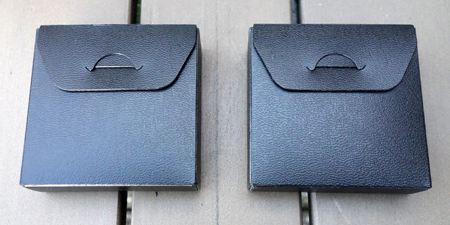 |
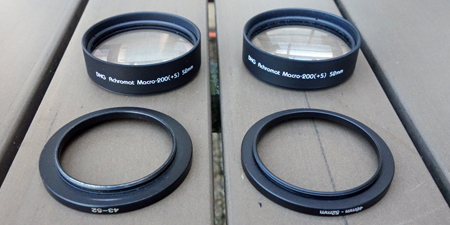 |
Photos: Marumi +5 achromats with step-up rings
Find my experiences with the Marumi +5 achromat and various lenses at the Leica M (Typ 240) on page Close-Up Options (Live View) - Part 2: Practice I.
Extension Tubes
Extension tubes (and extension bellows, see below) are placed between the camera body and the lens. They can be combined to achieve different extensions and thus, magnifications. They have the disadvantage that a light loss is involved: the longer the extension, the more light is lost. Some people say that image quality suffers, too, but I cannot comment on this.
Single Tubes
Here I present only the most common option for the Leica M - and a modern variation of it.
Leica OUFRO / Quenox Extension Tube
The Leitz OUFRO (16469Y) is an extension ring with M bayonet and an optical thickness of 1 cm (production era 1959-1983). It can be used to decrease the minimum focusing distance of rangefinder lenses, which tend to have a fairly long one (for example, about 1 m for a 50 mm lens). The extension ring can be stacked for achieving greater magnification (causing more light loss).
The Quenox Extension Tube for Leica M, distributed by enjoyyourcamera.com, replaces the Leitz OUFRO / Leitz 16469Y and is currently available (100 EUR). For photos, see below.
Tube Sets
There are obviously lots of vintage extension tubes and tube sets available for the Leica, but I will just mention one that is "up-to-date: the Novoflex Extension tube set Leica M ($200/200 EUR). I cite the text from the company's Website:
Thanks to its variable design the new LEM/VIS-II adapter set adds several new applications for Leica M240 photographers. It’s adapter and extension tube in one. The following options are available:
Depending on the use of the 3 inner rings magnifications between 0,28:1 – 0,84:1 can be achieved (50mm Leica M lens). |
In my case, only the third option is the one that would interest me here.
My Extension Tubes
I ordered a Quenox Extension Tube for Leica M (replaces the Leica OUFRO) to achieve a smaller focusing distance for my M-mount lenses, particularly for the 50 mm Zeiss Sonnar lens. Here are photos of the extension tube:
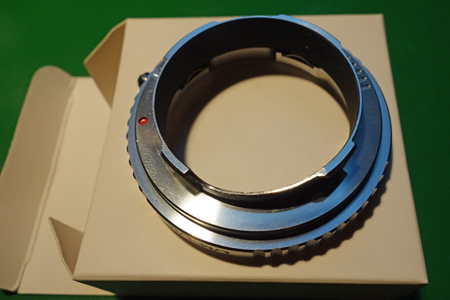 |
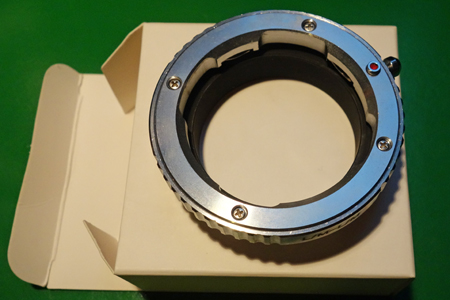 |
Photos: Quenox Extension Tube for Leica M
Find my experiences with the Quenox Extension Tube for Leica M at the Leica M (Typ 240) on page Close-Up Options (Live View) - Part 2: Practice I.
Extension Bellows
Extension bellows are based on the same principle as extension tubes. Therefore, they obey the same rule: Exposure needs to be prolonged, the longer the extension is. They are more flexible than extension tubes, because you can select any extension within the extension range of the bellows. But they are also bulkier und therefore typically used on a tripod or with a hand grip.
There are also special lenses, called lens heads, available for extension bellows, which lack a distance setting mechanism. You can also use lenses that are destined for enlargers (which also lack a distance setting mechanism).
There are not too many extension bellows out there. The company Novoflex still manufactures them, and there were also models from Leica, which have been discontinued. Novoflex now also offers adapted bellow systems for the Leica M (Typ 240) and S.
My Bellows
I owned a Novoflex extension bellows (BALPRO) with a slide copier, a 105 mm and a 60 mm lens head, plus M42, Canon, and Minolta adapters, all fully manual. Since I did not expect that I would use the bellows ever again, I regrettably sold all this...
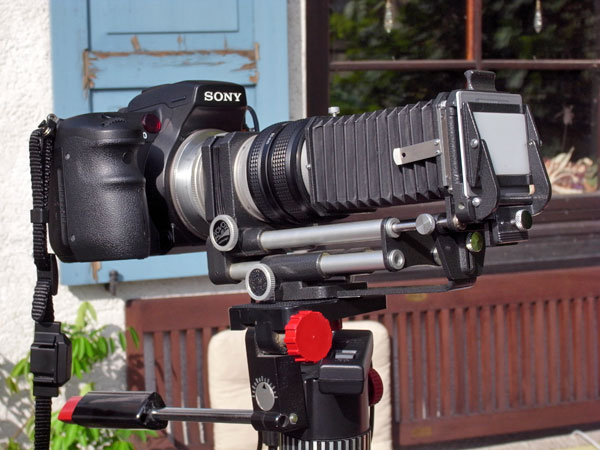 |
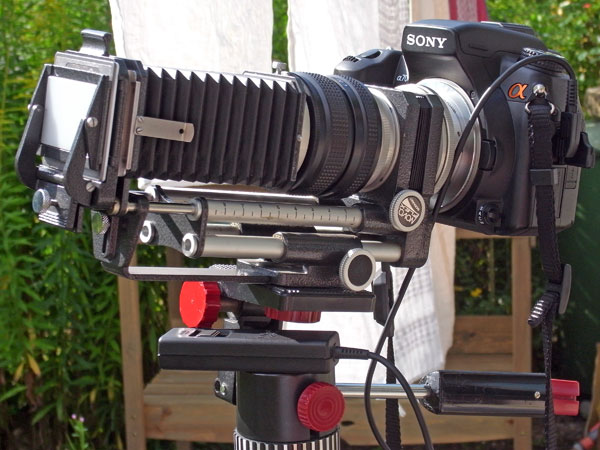 |
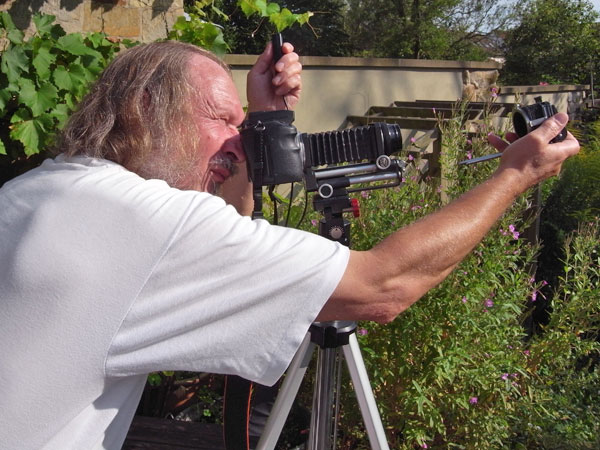 |
Photos: My Novoflex bellows on the Sony A700 with 60 mm lens head (left, center) and 105 mm lens head (right) (sold)
After I had bought the M-mount expansion unit for the Ricoh GXR, I purchased a old and used Leitz extension bellows (Bellows II, 16556) at eBay with the standard adapter (16558) for lens heads:
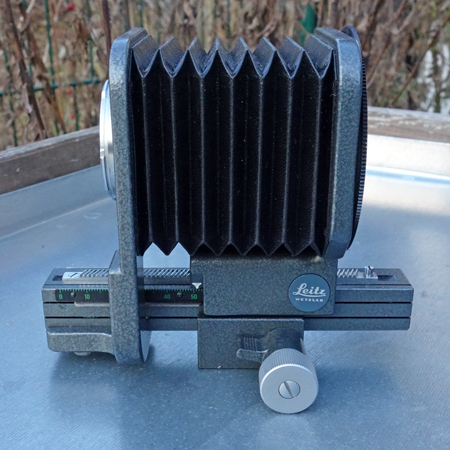 |
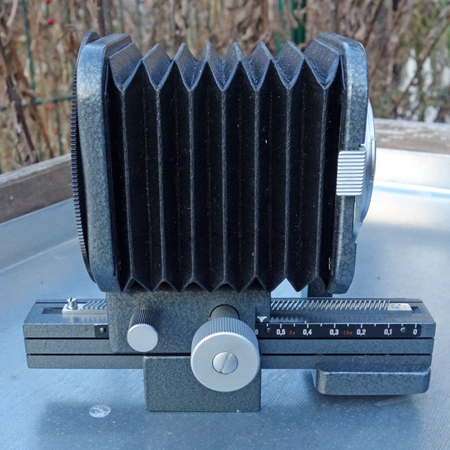 |
|
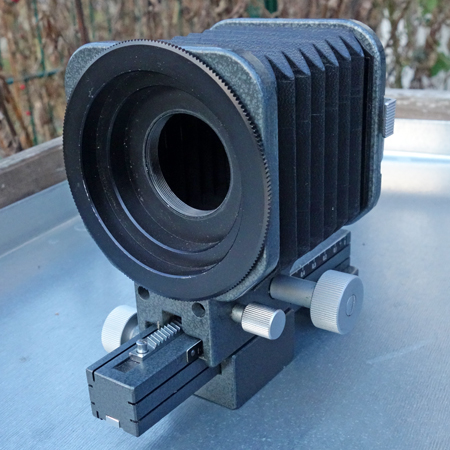 |
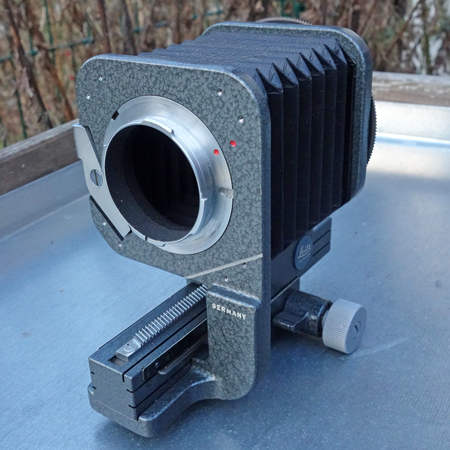 |
Photos: Leitz Bellows II
However, I was not able to find out, which adapters I would need for my 50 mm Nikon enlarger lens and my other M39 and M-mount lenses. The seller named some adapters, but these were not suitable for the bellows - and he admitted that he did not know much about bellows... So the bellows went into the cupboard for a longer sleep...
After purchasing a Leica M (Typ 240), my interest in the extension bellows revived, and I even found out the names of the adapters for M39 (16590) and M-mount (16596) lenses. So I tried to revive the bellows as well, even though I was still missing the needed M39 and M-mount adapters.
Find my experiences with the Bellows II at the Leica M (Typ 240) on page Close-Up Options (Live View) - Part 3: Practice II.
Macro Lenses
Macro lenses allow you to achieve higher magnifications without having to use any other gear, such as close-up lenses, extension tubes, or extension bellows. Of course, you can combine such a lens with extension tubes or bellows, in particular, in order to achieve even higher magnifications, but, of course, at the cost of ginving up simplicity...
Leica offers a macro lens, the Leica Macro-Elmar-M 1:4/90 mm, which, together with a dedicated extension tube, allows to achieve a magnification of up to 1:2. This lens is, however, beyond my "scope"... In January 2017, however, I learned of the existence of the Novoflex Noflexar 35mm f/3.5 lens in a thread in the l-camera-forum and tried to get one. I finally succeded - read more about this and the lens on page Novoflex Noflexar 35mm f/3.5.
My Macro Lens: Novoflex Noflexar 35mm f/3.5
I bought the Novoflex Noflexar 35mm f/3.5 macro lens in early 2017. The lens was sold by Novoflex, but was manufactured since 1962 by Staeble in Germany; it is no longer available from Novoflex.
The lens has an M42 mount (that is, it is the M42 version COWEIT), and I therefore ordered an M42-to-Leica M adapter from Novoflex (LEM/CO, 89 EUR) to be able to use the lens at my Leica M (Typ 240). Optionally, I can also use an extension tube, a Quenox Extension Tube for Leica M, to boost magnification a little. My "macro set" with the Noflexar lens therefore looks as follows:
Photo: Novoflex Noflexar 35mm f/3.5 lens with Novoflex LEM/CO adapter and Quenox Extension Tube for Leica M
Find my experiences with the Novoflex Noflexar 35mm f/3.5 lens at the Leica M (Typ 240) on page Close-Up Options (Live View) - Part 4: Practice III and also on page Novoflex Noflexar 35mm f/3.5.
Conclusions
It's all there and available for the Leica M (Typ 240) what you need to take close-up and even macro photos. I have acquired devices of all sorts, but they all need extensive testing (in the meantime, they are complete and ready to use).
I put up three "practice" pages entitled Close-Up Options (Live View) - Part 2: Practice I, Close-Up Options (Live View) - Part 2: Practice II and Close-Up Options (Live View) - Part 4: Practice III, where I report on my experiences with these devices.
And I also prepared three pages with sample close-up photos: Close-Up Options (Live View) - Part 5: Samples I, Close-Up Options (Live View) - Part 6: Samples II, and Close-Up Options (Live View) - Part 7: Samples III.
References
Visoflex
- Stephen Gandy (Cameraquest): Leica Visoflex System - adjusting in a digital world (www.cameraquest.com/LMVisoflex.htm)
- Wikipedia (in German): Visoflex (de.wikipedia.org/wiki/Visoflex)
Extension Tubes
- Novoflex: Extension tube set Leica M (www.novoflex.com/en/products/adapters/extension-tube-set-leica-m/) / Zwischenringsatz Leica M (www.novoflex.com/de/produkte/objektiv-adapter/zwischenringsatz-leica-m/)
- enjoyyourcamera: Quenox Zwischenring für Leica M - ersetzt Leica OUFRO bzw. Leitz 16469Y (http://www.enjoyyourcamera.com/Makrozubehoer/Makro-Zwischenringe/Quenox-Zwischenring-fuer-Leica-M-ersetzt-Leica-OUFRO-bzw-Leitz-16469Y::6791.html)
Extension Bellows
- Novoflex Company Website (www.novoflex.com/en/home (English), www.novoflex.com/de/home (German))
- Novoflex: Adapted bellow systems for the Leica M (Typ 240) and S (Universal-Balgengeräte für Leica M240 und Leica S) (www.novoflex.com/de/produkte/makrofotografie--blitztechnik/balgengeraete/universal-balgengeraete-fuer-leica-neu (German only))
Macro Lenses
- Novoflex Noflexar 35mm f/3.5 info sheet (Novoflex): www.macrolenses.de/bilder/Noflexar_Makro_en_02.pdf
| 04.07.2024 |
